Popular traditions in Tuscany

The Florence Museum is the ideal place from which to begin an anthropological itinerary through Tuscany, whose stages will consist of the numerous demo-ethno-anthropological museums that reflect the multiform popular traditions of the region. Often these museums have been created starting from the bottom, at the initiative of citizens or local associations, and have benefited a posteriori from the important tradition of demological studies, particularly active in Italian anthropological culture.
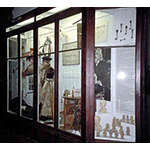
Paolo Mantegazza and ethnography in Tuscany
In the second half of the 19th century, anthropology in Tuscany was significantly promoted by the work of the physician and Darwinian anthropologist Paolo Mantegazza. To document the evolution of man and the development of civilisation, he founded the Florence Museo di Antropologia e Etnologia in 1869. It was the first anthropological university museum in Europe. That same year Mantegazza held the first Italian Chair in Anthropology at the Florence Institute of Higher Studies. In 1871 he funded the " Società Italiana di Antropologia ed Etnologia " [Italian Society of Anthropology and Ethnology] and instituted a specialised library. He was also the founder of the Italian Photographic Society, of great importance also for anthropology, since photographs was conceived as scientific evidence, often fundamentally important in showing contexts.
The Florence Museum goes beyond the regional and national dimension, displaying objects of physical and cultural anthropology collected during ethnographic expeditions, many of them in non-European countries. Of special historic interest are the anthropometric instruments constructed from the end of the 19th century through the first half of the 20th.
Among the smaller museums that contain non-European ethnographic materials are the Museo Missionario Etnografico Francescano at Fiesole, which displays ethnographic materials (clothing, musical instruments, prototypes of typographer's print, statuettes of jade, porcelain and ivory) collected by the missionaries, especially in China and Egypt; the Museo Civico at Montaione which, in a space dedicated to ethnography, exhibits a collection of African objects, and lastly, the collections of the Museo del Castello di Porciano, which present, in a special section, objects of nineteenth-century craftsmanship made by the Sioux Indians of North Dakota.
-
 Museo Civico [Civic Museum]
Museo Civico [Civic Museum] -
 Museo del Castello di Porciano [Porciano Castle Museum]
Museo del Castello di Porciano [Porciano Castle Museum] -
 Museo di Storia Naturale di Firenze - Sezione di Antropologia ed Etnologia [Florence Museum of Natural History - Anthopology Section]
Museo di Storia Naturale di Firenze - Sezione di Antropologia ed Etnologia [Florence Museum of Natural History - Anthopology Section] -
 Museo Missionario Etnografico Francescano [Franciscan Ethnographic Missionary Museum]
Museo Missionario Etnografico Francescano [Franciscan Ethnographic Missionary Museum]
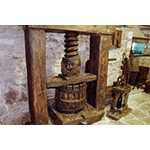
A scientific itinerary through popular traditions
Demology, the term used to indicate studies in popular culture, constitutes a significant sphere of cultural anthropology. The latter developed as a scientific-social discipline in the complex debate that originated in Europe and the United States in the second half of the 19th century, although projects for implementing a science of human cultures had already emerged during the previous century.
Interest in popular traditions, in everyday customs and conceptions, received a strong stimulus from the Romantic-Risorgimental emphasis on the concept of "a people", conceived as the "soul" of a nation, whose spontaneity and authenticity were contrasted with the artificial nature of "high" culture.
In Italy, studies on the origins of the heritage of oral tradition, passed down from one generation to another through folktales, legends, songs, and proverbs, developed later than in other European nations, such as Germany and Great Britain. For much of the 19th century, Italian research in this field concentrated on popular poetry. However, around the middle of the 20th century, demo-ethno-anthropological activity was intensified, favoured by the reflections of Ernesto De Martino and by the analysis of folklore conducted by Antonio Gramsci.
The specificity of the subject of study, the ensuing constitution of a relatively independent disciplinary sphere, the development of controlled, rigourous methodologies, the definition of increasingly refined techniques of investigation, and the elaboration of a specific language, have definitively placed cultural anthropology, and consequently demology as well, within the sphere of the human social sciences. We are thus fully entitled to include within the historic-scientific itineraries one of demological character.
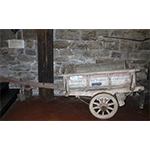
Ethnographic itineraries in Tuscany
From the mountains to the valleys, from the countryside to the swamps, Tuscany is scattered with a multitude of demo-ethno-anthropological museums that document the spiritual and material heritage of the orally transmitted cultures. They constitute a fundamental key of access both for understanding the traditional culture of the people and its dynamic relationship with the life of today, and for grasping the element of folklore and separating it from the mere celebration of tourist consumption. These museums display mainly objects from the 19th and the 20th centuries, although items from the immediately preceding centuries are also present. The main objective of these institutions is that of preserving, conserving and regenerating in the collective memory the organisation of work in the past and the rural social structure, with no futile celebratory intention.
The particular identity of the people of a region is formed not only thanks to the urban contexts with their historic-political vicissitudes, deposited in the collective imagination through the organisation of the big cities, but also by the complementary activities of the rural cultures that, over the centuries, moulded an exceptionally varied landscape, often celebrated in the journals of travellers. Ample fragments of this landscape still remain today. And it is just from these fragments that voyages into the traditions of the mountains, the rural hill districts, the valleys and the plains can start, through the wine roads and the marshes. Since these museums are very widespread, the itinerary, if it is to be followed, is obliged to make a selection from all of those proposed.
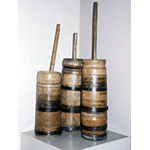
Daily life in the mountains
The traditions of the mountains are recorded by an extensive system of museums that covers the entire Apennine and sub-Apennine territory.
The agricultural, pastoral, craftsmen's and domestic activities and the people's culture of the Lunigiana are presented in the Museo Etnografico della Lunigiana at Villafranca and in the Raccolta Museale "Mario Nadotti" at Lusignana. The Museo Etnologico delle Apuane "Luigi Bonacoscia" at Massa documents instead the popular culture of the coastal band. Along with objects relating to domestic, rural and craftsmen's activities, we also find evidence of the mining and working of marble. Marble-working is well illustrated also by the Museo del Lavoro e delle Tradizioni Popolari della Versilia Storica, located in the beautiful Medicean palazzo at Seravezza.
Testimony of rural activities in Garfagnana is found in the rich ethnographic collections of the Museo Etnografico Provinciale "Don Luigi Pellegrini" at San Pellegrino in Alpe. The various stages of exploitation of chestnut groves with the relevant tools are displayed at the Museo del Castagno in Colognora. Original is the Museo della Figurina di Gesso e dell’Emigrazione at Coreglia Antelminelli, which documents the activity of fabricating plaster figurines and the phenomenon of emigration of the "figurinaio" in the Middle Valley of the Serchio from the 17th century to our own day.
The multiform activities of the Pistoian mountains are recorded in the various sections of the Ecomuseum. At Rivoreta visitors will find the Museo della Gente dell’Appennino Pistoiese, which displays an ethnographic collection containing objects of everyday use and tools of work typical of mountain activities (charcoal burner, woodsman). At Pàvana the Polo Didattico della Pietra offers informative panels and educational materials, in addition to itineraries along which are shown objects linked to the art of stone-cutting. At Pracchia the historic Sabatini Ironworks illustrates the world of iron-working in the Apennines, documented also in the Museo del Ferro at Ponte Petri. Daily life in the Pistoian Mountains, from the processing of chestnuts to the production of charcoal, is presented at Val d’Orsigna and in the Museo del Carbonaio at Baggio. At Piastre, the Ice Production Department of the Madonnina shows visitors the ice-works and the relevant hydraulic facilities for obtaining natural ice by freezing. The traditional activities of mining and working pietra serena at Vellano, the capital of the "Swiss Pesciatina", are presented at the Museo Storico Etnografico del Minatore e del Cavatore.
In the Florentine mountains, at Raggioli, we find the Museo della Civiltà Contadina e dell’Artigianato della Montagna, which possesses an ethnographic collection pertinent to mountain life with objects of common use, the tools of shoemakers and blacksmiths, and implements for work in the fields and the forests. Similar collections are numerous also in Mugello. In the tiny village of Grezzano, in a remodelled country house, is the Museo della Civiltà Contadina di Casa d’Erci; located in the basement of the Firenzuola Fortress is the Museo della Pietra Serena. Still in the Commune of Firenzuola we can visit the Museum of the Historic Apennines Landscape at Moscheta and the Museo Storico Etnografico di Bruscoli. Life in the Apennines is recorded again in the fourteenth-century Palazzo dei Capitani, site of the Museum of the Mountain People at Palazzuolo sul Senio. A replica in miniature of craftsmen's and peasants' settings can be seen in the Museo di Vita Contadina e Artigiana con Personaggi in Movimento at Sant’Agata. A voyage through the trades in Mugello can conclude at the Museo dei Ferri Taglienti, which documents the culture and production of knives typical of the town of Scarperia.
The traditions, beliefs, customs and usages of the agrarian-forestry-herding culture typical of Casentino are recorded in the various sections of the Ecological Museum. They consist of the Centro di Documentazione della Cultura Rurale del Casentino in the ancient village of Castel Focognano, the Museo della Casa Contadina at Subbiano, the Museo del Bosco e dalla Montagna at Stia, the Museo della Castagna of Raggiolo and Ortignano, the Museo del Carbonaio and the Museo della Civiltà Castellana at San Niccolò. In addition, the various ways in which water was used, ranging from basic nutritional resource to determinant element for producing electric power to drive the machines of mills, fullers and iron-works, are illustrated in the Museo dell’Acqua at Capolona. Lastly, the collections of tools linked to the peasant world, objects of everyday use, implements for spinning wool and ancient furnishings at the San Niccolò Castle are interesting to visit.
The rural life and craftsmanship of the Amiata mountain area are recorded in the nineteenth- and twentieth-century collections of the Casa Museo di Monticello Amiata and the Museo Etnografico of Santa Caterina. Particularly interesting is the Parco Museo della Peschiera at Santa Fiora.
-
 Casa Museo di Monticello Amiata [Monticello Amiata Museum House]
Casa Museo di Monticello Amiata [Monticello Amiata Museum House] -
 Castello di San Niccolò [Castle of San Niccolò]
Castello di San Niccolò [Castle of San Niccolò] -
 Ecomuseo del Casentino - Centro di Documentazione della Cultura Rurale del Casentino [Casentino Ecomuseum - Rural Culture in Casentino Documentation Centre]
Ecomuseo del Casentino - Centro di Documentazione della Cultura Rurale del Casentino [Casentino Ecomuseum - Rural Culture in Casentino Documentation Centre] -
 Ecomuseo del Casentino - Museo del Bosco e della Montagna [Casentino Ecomuseum- Museum of the Forests and Mountains]
Ecomuseo del Casentino - Museo del Bosco e della Montagna [Casentino Ecomuseum- Museum of the Forests and Mountains] -
 Ecomuseo del Casentino - Museo del Carbonaio [Casentino Ecomuseum - Charcoal Burner's Museum]
Ecomuseo del Casentino - Museo del Carbonaio [Casentino Ecomuseum - Charcoal Burner's Museum] -
 Ecomuseo del Casentino - Museo della Casa Contadina [Casentino Ecomuseum - Peasant's House Museum]
Ecomuseo del Casentino - Museo della Casa Contadina [Casentino Ecomuseum - Peasant's House Museum] -
 Ecomuseo del Casentino - Museo della Castagna [Casentino Ecomuseum - Chestnut Museum]
Ecomuseo del Casentino - Museo della Castagna [Casentino Ecomuseum - Chestnut Museum] -
 Ecomuseo del Casentino - Museo della Civiltà Castellana [Casentino Ecomuseum - Museum of Castle Civilisation]
Ecomuseo del Casentino - Museo della Civiltà Castellana [Casentino Ecomuseum - Museum of Castle Civilisation] -
 Ecomuseo del Casentino - Museo dell'Acqua [Casentino Ecomuseum - Water Museum]
Ecomuseo del Casentino - Museo dell'Acqua [Casentino Ecomuseum - Water Museum] -
 Ecomuseo della Montagna Pistoiese - Comparto Produttivo del Ghiaccio della Madonnina [Pistoian Mountain Ecomuseum - 'Madonnina' Ice Production Division]
Ecomuseo della Montagna Pistoiese - Comparto Produttivo del Ghiaccio della Madonnina [Pistoian Mountain Ecomuseum - 'Madonnina' Ice Production Division] -
 Ecomuseo della Montagna Pistoiese - Ferriera Sabatini [Pistoian Mountain Ecomuseum - Sabatini Ironworks]
Ecomuseo della Montagna Pistoiese - Ferriera Sabatini [Pistoian Mountain Ecomuseum - Sabatini Ironworks] -
 Ecomuseo della Montagna Pistoiese - Molino di Giamba e di Berto e la Via del Carbone [Pistoia Mountains Ecological Museum - Mill of Giamba and Berto and the Charcoal Road]
Ecomuseo della Montagna Pistoiese - Molino di Giamba e di Berto e la Via del Carbone [Pistoia Mountains Ecological Museum - Mill of Giamba and Berto and the Charcoal Road] -
 Ecomuseo della Montagna Pistoiese - Museo del Ferro [Pistoian Mountain Ecomuseum - Iron Museum]
Ecomuseo della Montagna Pistoiese - Museo del Ferro [Pistoian Mountain Ecomuseum - Iron Museum] -
 Ecomuseo della Montagna Pistoiese - Museo della Gente dell'Appennino Pistoiese [Pistoia Mountains Ecomuseum - Museum of the Pistoia Apennines People]
Ecomuseo della Montagna Pistoiese - Museo della Gente dell'Appennino Pistoiese [Pistoia Mountains Ecomuseum - Museum of the Pistoia Apennines People] -
 Ecomuseo della Montagna Pistoiese - Polo Didattico della Pietra [Pistoia Mountains Ecomuseum - Educational Centre for Stone]
Ecomuseo della Montagna Pistoiese - Polo Didattico della Pietra [Pistoia Mountains Ecomuseum - Educational Centre for Stone] -
 Museo dei Ferri Taglienti - Palazzo dei Vicari [Museum of Cutting Implements - Palazzo dei Vicari]
Museo dei Ferri Taglienti - Palazzo dei Vicari [Museum of Cutting Implements - Palazzo dei Vicari] -
 Museo del Carbonaio [Charcoal Burners' Museum]
Museo del Carbonaio [Charcoal Burners' Museum] -
 Museo del Castagno [Chestnut Museum]
Museo del Castagno [Chestnut Museum] -
 Museo del Paesaggio Storico dell'Appennino di Moscheta [Moscheta Historic Apennines Landscape Museum]
Museo del Paesaggio Storico dell'Appennino di Moscheta [Moscheta Historic Apennines Landscape Museum] -
 Museo della Civiltà Contadina di Casa d'Erci [Casa d'Erci Museum]
Museo della Civiltà Contadina di Casa d'Erci [Casa d'Erci Museum] -
 Museo della Figurina di Gesso e dell'Emigrazione [Museum of Plaster Figurines and Emigration]
Museo della Figurina di Gesso e dell'Emigrazione [Museum of Plaster Figurines and Emigration] -
 Museo della Pietra Serena [Museum of Pietra Serena]
Museo della Pietra Serena [Museum of Pietra Serena] -
 Museo delle Genti di Montagna [Museum of the Mountain People]
Museo delle Genti di Montagna [Museum of the Mountain People] -
 Museo di Vita Contadina e Artigiana con Personaggi in Movimento di Sant'Agata [Sant'Agata Museum of Peasant Life and Craftsmanship with Animated Figures]
Museo di Vita Contadina e Artigiana con Personaggi in Movimento di Sant'Agata [Sant'Agata Museum of Peasant Life and Craftsmanship with Animated Figures] -
 Museo Etnografico della Lunigiana [Lunigiana Ethnographic Museum]
Museo Etnografico della Lunigiana [Lunigiana Ethnographic Museum] -
 Museo Etnografico Provinciale 'Don Luigi Pellegrini' ['Don Luigi Pellegrini' Provincial Ethnographic Museum]
Museo Etnografico Provinciale 'Don Luigi Pellegrini' ['Don Luigi Pellegrini' Provincial Ethnographic Museum] -
 Museo Etnografico Santa Caterina [Santa Caterina Ethnographic Museum]
Museo Etnografico Santa Caterina [Santa Caterina Ethnographic Museum] -
 Museo Etnologico delle Apuane 'Luigi Bonacoscia' ['Luigi Bonacoscia' Ethnological Museum of the Apuanes]
Museo Etnologico delle Apuane 'Luigi Bonacoscia' ['Luigi Bonacoscia' Ethnological Museum of the Apuanes] -
 Museo Storico Etnografico del Minatore e del Cavatore [Ethnographic Historical Museum of Miners and Quarrymen]
Museo Storico Etnografico del Minatore e del Cavatore [Ethnographic Historical Museum of Miners and Quarrymen] -
 Museo Storico Etnografico di Bruscoli [Bruscoli Historic Ethnographic Museum]
Museo Storico Etnografico di Bruscoli [Bruscoli Historic Ethnographic Museum] -
 Palazzo Mediceo di Seravezza - Museo del Lavoro e delle Tradizioni Popolari della Versilia Storica [Palazzo Mediceo di Seravezza - Museum of Work and Folk Traditions in Historical Versilia]
Palazzo Mediceo di Seravezza - Museo del Lavoro e delle Tradizioni Popolari della Versilia Storica [Palazzo Mediceo di Seravezza - Museum of Work and Folk Traditions in Historical Versilia] -
 Parco Museo della Peschiera ['Peschiera' Museum Park]
Parco Museo della Peschiera ['Peschiera' Museum Park] -
 Raccolta Museale 'Mario Nadotti' ['Mario Nadotti' Museum Collection]
Raccolta Museale 'Mario Nadotti' ['Mario Nadotti' Museum Collection]
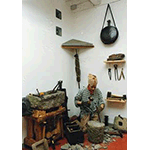
The rural world in the hills, valleys and plains
There are also numerous ethnographic museums that record rural activity in the valleys and on the plains of the regional territory.
Peasant life on the plain of Lucca is well documented by the Mostra Permanente Attrezzi di Vita Contadina at San Leonardo in Treponzio and by the Mostra Etnografica Permanente at Capannori.
At Vaiano we can visit the Centro di Documentazione Storico-Etnografica of the Val di Bisenzio, which aims to safeguard the historic memory of the territory through its collections of objects from rural life. The implements used in the various stages of the local proto-industry are also documented.
Peasant life on the Florentine plain is illustrated in the Raccolta Etnografica "Casa del Guidi" at Sesto Fiorentino. In addition, the Museo della Paglia e dell'Intreccio "Domenico Michelacci" at Signa displays tools, products, objects and iconographic material relevant to the fabrication and marketing of straw products at Signa and throughout the world, recording an extraordinary heritage linked to Tuscan economy from the 18th through the 20th century.
In Valdarno we find the interesting Museo della Civiltà Contadina, situated in the monumental complex of the Pieve di San Romolo at Gaville, and the Museo dei Mestieri e delle Arti del Legno at Cascina, which aims to trace and valorise the evolution of the ancient woodworking crafts around which the local economy centred.
In Valdera the Museo del Lavoro e della Civiltà Rurale at San Gervasio di Palaia displays objects pertinent to animal husbandry, weaving, the production of olive oil and wine, craftsmen's activities and daily life. A permanent exhibition of Peasant Civilisation has also been set up at Montefoscoli.
Agricultural and craftsmen's activities in the Val di Cecina are documented by the Museo della Civiltà Contadina at Montecastelli Pisano. At Cecina, in the eighteenth-century Villa Guerrazzi, is the Museo della Vita e del Lavoro della Maremma Settentrionale. Further south, at Venturina, we find the Museo della Civiltà del Lavoro, which records rural and production activities in the Val di Cornia. In the Museo di Storia Locale "Ildebrando Imberciadori" at Montepescali we find other implements from the local peasants' civilization. Still further to the south, at Albinia, the Museo della Cultura Contadina illustrates aspects distinctive of rural activities in the southern plains of Tuscan Maremma, especially as regards the period ranging from the early 20th century to the time of Land Reform.
Moving on to the Sienese territory, at Buonconvento we can visit the Sharecroppers' Museum, which aims to commemorate a social and production model, now prohibited and disappeared, that was very widespread in Tuscany. The sharecroppers' world is also presented by the Museo etnografico del Bosco e della Mezzadria at Sovicille. In addition, in the Sienese countryside, at Serre di Rapolano, is the Museum of the Museo dell'Antica Grancia di Serre; in it is a museum divided into two sections: the Grange Documentation Centre and the Olive Oil Museum, housed in an ancient olive-mill. Olive-growing and the production of olive oil are also documented in the Ancient Olive-mill at Massa Marittima, where there is also an Ancient Carpenter's Shop, the faithful replica of a traditional one.
-
 Ancient Oil-press
Ancient Oil-press -
 Antica Falegnameria [Old Carpenter's Workshop]
Antica Falegnameria [Old Carpenter's Workshop] -
 Mostra Etnografica Permanente - Museo Contadino della Piana di Lucca - Associazione Culturale 'Ponte' [Permanent Ethnographic Exhibition - Piana di Lucca Peasant Culture Museum - 'Ponte' Cultural Association]
Mostra Etnografica Permanente - Museo Contadino della Piana di Lucca - Associazione Culturale 'Ponte' [Permanent Ethnographic Exhibition - Piana di Lucca Peasant Culture Museum - 'Ponte' Cultural Association] -
 Mostra Permanente Attrezzi di Vita Contadina - Associazione Culturale 'La Ruota' [Implements of Peasant Life Permanent Exhibition - 'La Ruota' Cultural Association]
Mostra Permanente Attrezzi di Vita Contadina - Associazione Culturale 'La Ruota' [Implements of Peasant Life Permanent Exhibition - 'La Ruota' Cultural Association] -
 Mostra permanente della Civiltà Contadina [Peasant Civilisation Permanent Exhibition]
Mostra permanente della Civiltà Contadina [Peasant Civilisation Permanent Exhibition] -
 Museo dei Mestieri e delle Arti del Legno [Museum of Woodworking Arts and Crafts]
Museo dei Mestieri e delle Arti del Legno [Museum of Woodworking Arts and Crafts] -
 Museo del Lavoro e della Civiltà Rurale di San Gervasio [San Gervasio Museum of Work and Rural Civilisation]
Museo del Lavoro e della Civiltà Rurale di San Gervasio [San Gervasio Museum of Work and Rural Civilisation] -
 Museo della Civiltà Contadina [Museum of Peasant Culture]
Museo della Civiltà Contadina [Museum of Peasant Culture] -
 Museo della Civiltà Contadina di Montecastelli Pisano [Montecastelli Pisano Museum of Peasant Civilisation]
Museo della Civiltà Contadina di Montecastelli Pisano [Montecastelli Pisano Museum of Peasant Civilisation] -
 Museo della Civiltà del Lavoro [Museum of Work]
Museo della Civiltà del Lavoro [Museum of Work] -
 Museo della Cultura Contadina [Museum of Peasant Culture]
Museo della Cultura Contadina [Museum of Peasant Culture] -
 Museo della Mezzadria [Sharecroppers' Museum]
Museo della Mezzadria [Sharecroppers' Museum] -
 Museo della Paglia e dell'Intreccio 'Domenico Michelacci' ['Domenico Michelacci' Straw and Straw-weaving Museum']
Museo della Paglia e dell'Intreccio 'Domenico Michelacci' ['Domenico Michelacci' Straw and Straw-weaving Museum'] -
 Museo della Vita e del Lavoro della Maremma Settentrionale [Museum of Life and Work in Northern Maremma]
Museo della Vita e del Lavoro della Maremma Settentrionale [Museum of Life and Work in Northern Maremma] -
 Museo dell'Antica Grancia di Serre [Museum of the Ancient Serre Grange]
Museo dell'Antica Grancia di Serre [Museum of the Ancient Serre Grange] -
 Museo di Storia Locale 'Ildebrando Imberciadori' ['Ildebrando Imberciadori' Museum of Local History]
Museo di Storia Locale 'Ildebrando Imberciadori' ['Ildebrando Imberciadori' Museum of Local History] -
 Museo etnografico del Bosco e della Mezzadria [Ethnographic Museum of Forests and Sharecropping]
Museo etnografico del Bosco e della Mezzadria [Ethnographic Museum of Forests and Sharecropping] -
 Raccolta Etnografica 'Casa del Guidi' ['Casa del Guidi' Ethnographic Collection]
Raccolta Etnografica 'Casa del Guidi' ['Casa del Guidi' Ethnographic Collection]
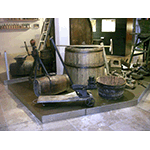
Grapes and wine
The world linked to the production of wine, which, along with olive oil, represents one of the most typical products of the region, is well represented in many museums, both with specific sections dedicated to the world of winegrowing, and with "theme" museums. Among the latter are the Carmignano Museum of Grapes and Wine, which documents the long history of wine production, a history that originated in the work of promotion launched by the Medici Grand Dukes.
In the historic Villa di Poggio Reale is the Museo della Vite e del Vino del Chianti Rufina. The exhibition displays instruments and machinery for cultivating grapes and for the production and conservation of wine in use from 1930 to 1960. The museum's facilities also include an important historical library, which contains volumes, documents, photographs and films on various aspects of winegrowing. In the Chianti territory, the Museo "Emilio Ferrari" di Cultura Contadina at San Donato in Poggio displays tools of work bearing witness to the rural culture of the Chianti area. Specific sections are dedicated to olive-growing and winegrowing. At Radda the Piccolo Museo del Chianti aims to give an idea of peasant life in Chianti prior to the exodus from the countryside.
At Montespertoli, in the Empoli area, we find the Museo della Vite e del Vino del Centro per la Cultura del Vino "I Lecci", which illustrates the various stages of winemaking: from harvesting the grapes, to vinification, to bottling.
Lastly, the wine-producing activity of the Maremma countryside is recorded in the museums of Grapes and Wine at Roccastrada and at Scansano.
-
 Museo della Vite e del Vino del Centro per la Cultura del Vino 'I Lecci' ['I Lecci' Wine Culture Centre Museum of Grapes and Wine]
Museo della Vite e del Vino del Centro per la Cultura del Vino 'I Lecci' ['I Lecci' Wine Culture Centre Museum of Grapes and Wine] -
 Museo della Vite e del Vino del Chianti Rufina [Chianti Rufina Museum of Grapes and Wine]
Museo della Vite e del Vino del Chianti Rufina [Chianti Rufina Museum of Grapes and Wine] -
 Museo della Vite e del Vino di Carmignano [Carmignano Museum of Grapes and Wine]
Museo della Vite e del Vino di Carmignano [Carmignano Museum of Grapes and Wine] -
 Museo della Vite e del Vino di Roccastrada [Roccastrada Museum of Grapes and Wine]
Museo della Vite e del Vino di Roccastrada [Roccastrada Museum of Grapes and Wine] -
 Museo della Vite e del Vino di Scansano [Scansano Museum of Grapes and Wine]
Museo della Vite e del Vino di Scansano [Scansano Museum of Grapes and Wine] -
 Museo 'Emilio Ferrari' di Cultura Contadina ['Emilio Ferrari' Museum of Peasant Culture]
Museo 'Emilio Ferrari' di Cultura Contadina ['Emilio Ferrari' Museum of Peasant Culture] -
 Piccolo Museo del Chianti [Little Museum of Chianti]
Piccolo Museo del Chianti [Little Museum of Chianti]
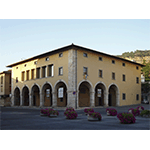
Activities typical of the wet zones
The interactions between man and the swampy environment are documented by the Museo della Città e del Territorio at Monsummano Terme, which has a section on the Fucecchio swamps.
Numerous tools and photographs illustrate the working methods and production cycles linked to fishing; the means of navigation employed and the harvesting of palaustrine plants. An exhibition dedicated to activities in the marshy areas is also found at the Museo Storico della Caccia e del Territorio located in the beautiful Medicean Villa of Cerreto Guidi.
The ancient trades linked to the wet zones are also recorded in the Museo della Pesca e delle Tradizioni Lagunari at Talamone. Implements, vintage photographs and traditional tools for the various types of lagoon fishing illustrate the activities carried out in the lagoon of Orbetello.
-
 Acquario della Laguna - Museo della Pesca e delle Tradizioni Lagunari [Aquarium of the Lagoon - Museum of Fishing and Lagoon Traditions]
Acquario della Laguna - Museo della Pesca e delle Tradizioni Lagunari [Aquarium of the Lagoon - Museum of Fishing and Lagoon Traditions] -
 Museo della Città e del Territorio [Museum of the City and Territory]
Museo della Città e del Territorio [Museum of the City and Territory] -
 Villa Medicea di Cerreto Guidi - Museo Storico della Caccia e del Territorio [Medici Villa at Cerreto Guidi - Historical Museum of Hunting and the Territory]
Villa Medicea di Cerreto Guidi - Museo Storico della Caccia e del Territorio [Medici Villa at Cerreto Guidi - Historical Museum of Hunting and the Territory]
****************************
Texts by Graziano Magrini
English translation by Catherine Frost
Last update 28/feb/2008


